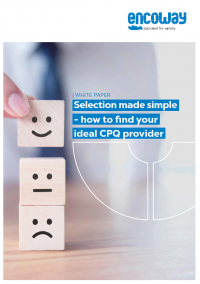“We need a product configurator that both our sales department and our customers can use. It must be able to provide support for the preparation of quotes and also help to impress customers on the website with our products”.
In discussions with companies that want to introduce a new configurator, I have often been told that they hope to reach all the target groups with „the configurator“. Not only should the sales department be able to generate accurate quotes quickly and efficiently, but at the same time it should help to impress potential new customers with the company’s innovative products. In other words this involves entering complex data, while at the same time allowing the customer to experience the product portfolio in a fun and interesting way. It is obvious that this balancing act is not an easy task.
Many companies try the all-in-one approach: the configurator on the website is overloaded with selection and input options to allow both the visitor to the website and the company’s own sales department to use it. There is, however, a real danger that it will now no longer be fun to use for any of the user groups. And login mechanisms that display only part of the configurator to the individual user groups tend to make the system more complicated and less easy to use.
Other companies choose an approach with separate solutions. They hire a web design agency to develop a web configurator that can be seamlessly integrated into the existing web design. And at the same time they acquire a sales configurator for generating quotes, with a different structure to that of the web application. This approach is time-consuming, expensive and error-prone because data from different systems have to be maintained simultaneously!
There is, however, a solution that makes it possible to address various user groups with just one database.
“The” product configurator does not exist!
First of all, forget the idea of a monolithic product configurator. Software in which the database and the user front end are directly intertwined is no longer state of the art. Today’s business applications follow the platform school of thought, i.e. they keep the programme logic, data, and visual appearance separate.
It is useful to think of it as similar to the evolution of mobile phones: just a few years ago, people had a mobile phone simply for making phone calls. At the same time they had an electronic organiser for their appointments and a separate navigation device for getting from A to B. Each of these systems had its own purpose and separate data storage. It was, however, inconvenient if one of your friends moved to a new address and you had to enter this into all three devices.
Today you are likely to have a smartphone which you can use to make calls and manage appointments and which also functions as a navigation device. This is, however, not carried out in a single application. The individual functions are encapsulated in “apps”, but utilise the same central platform and share the same databases, for example address lists. This is a good way to envisage your configuration platform.
The solution: implementing a platform strategy
Central to your new product configurator should be a sustainable platform. This platform is really nothing more than a piece of technology without a “face” for the user. It manages your product data and a set of rules that describe the relationship between the individual product components. This information is managed via maintenance software which is usually part of the platform. The central set of rules usually contains both technical dependencies which are used by your experts (for example, for an ambient temperature of 78°C and above, a different cable sheathing is used), and rules for the layman (for example, “where do you want to insert the cable?” – If the option “furnace” is selected, then a temperature of >78°C is taken into account). The way in which the data are presented to the user is intentionally not part of this platform.
On this basis, you can set up various apps, for example your sales configurator for quotations, or a web configurator for end customers.
The sales configurator does not usually have to come with a promotionally-effective user interface, because it is used as traditional desktop software by your staff. Here, the emphasis is on efficiency. Here, the emphasis is on efficiency. The sales employee wants to be able to generate an attractive-looking and at the same time accurate quotation with minimum effort. An exciting design for the user interface with lots of pictures will only interfere with this. Because the sales configurator generates a legally binding document, all the necessary data for an accurate quote must be present. Depending on the product, a large amount of input may be necessary here.
First, let us take a look at the configurator for end customers. This is usually found on a website. It does not aim to generate quotes but to show the products in an attractive way, and to encourage the user to try them out and ask the sales department for more information. End customers are not willing – and often not even able – to answer many technical questions. Instead they want to find out if their requirements can be met with your product. They want to experience the product. The configurator on the website may be less efficient, but it must be visually appealing and if possible even fun to use.
Do you also sell your products via dealers? Then make sure that you include this sales channel in the web configurator. Dealers are usually better at handling your portfolio than your end customers, but less proficient than your sales department. The corresponding configurator serves to make the dealers’ lives as easy as possible, so that they enjoy selling your products.
The ideal solution is the platform strategy
Every user group has its own requirements, and in competition, the winner is usually the one who has provided perfect support for perspective customers before closing the sale. If you attempt to satisfy the varying needs of different users using individual software for each of them, you will develop a whole range of insular solutions. One single configurator for all user groups will become a nondescript solution that does not really appeal to anyone. The ideal solution is the platform strategy.
A platform strategy guarantees a sustainable future
The purchase of new configuration software is usually a major financial investment. It also involves project durations that tie up important human resources. Building a central configuration platform is advisable even if only to lay a valuable foundation on which other business applications can be gradually built. If you later plan to launch, for example, a mobile configurator for use on tablet computers, then no major software project is necessary because the functional base is already available. This will only involve a minor expansion project, which maps the processes of the mobile application. The logic and rules are basically already available, or can be expanded, should the tablet application have to address different questions to those in the previous apps.
And one final note: it is always important that the product data and logic (the “product model”) are built up so intelligently right from the start that they can be expanded in the long term. And make sure you get support from experienced consultants and product modellers.

Head of Sales and Marketing, encoway GmbH
LinkedIn





